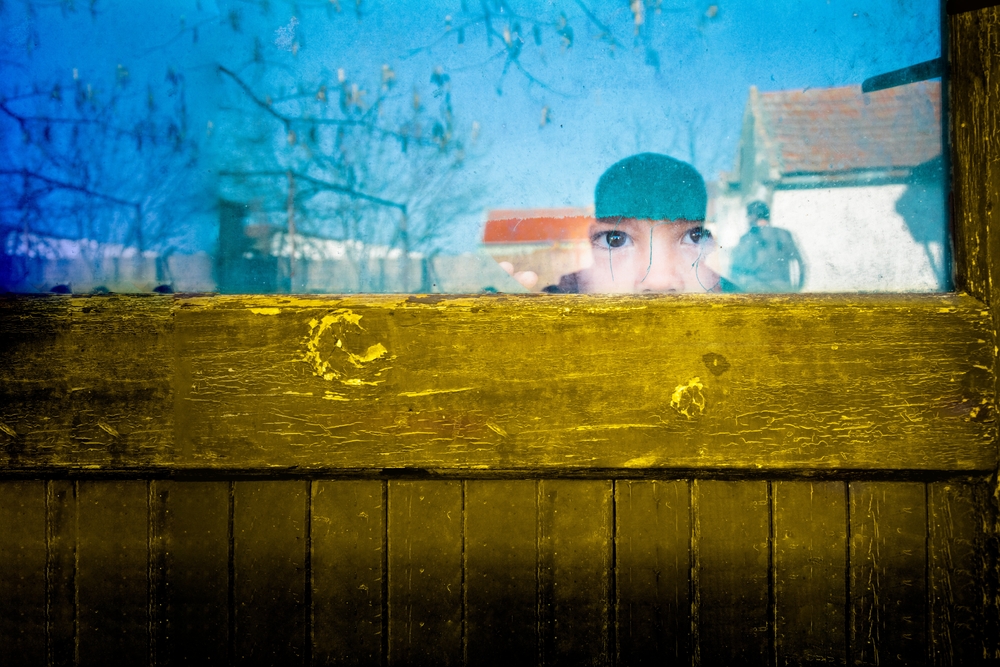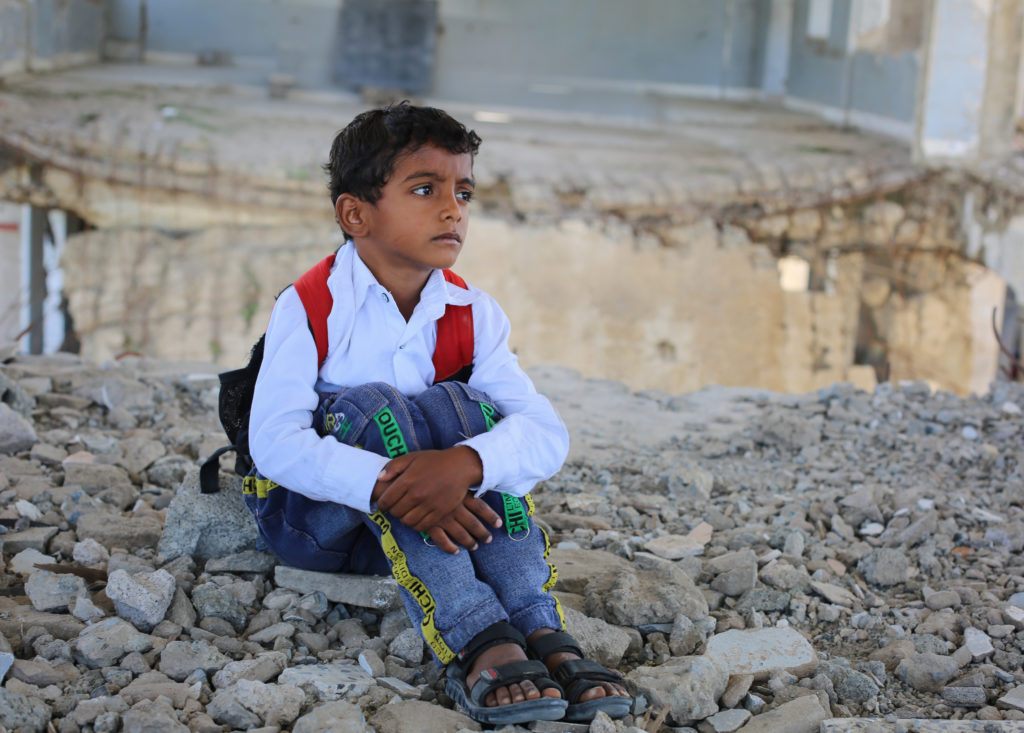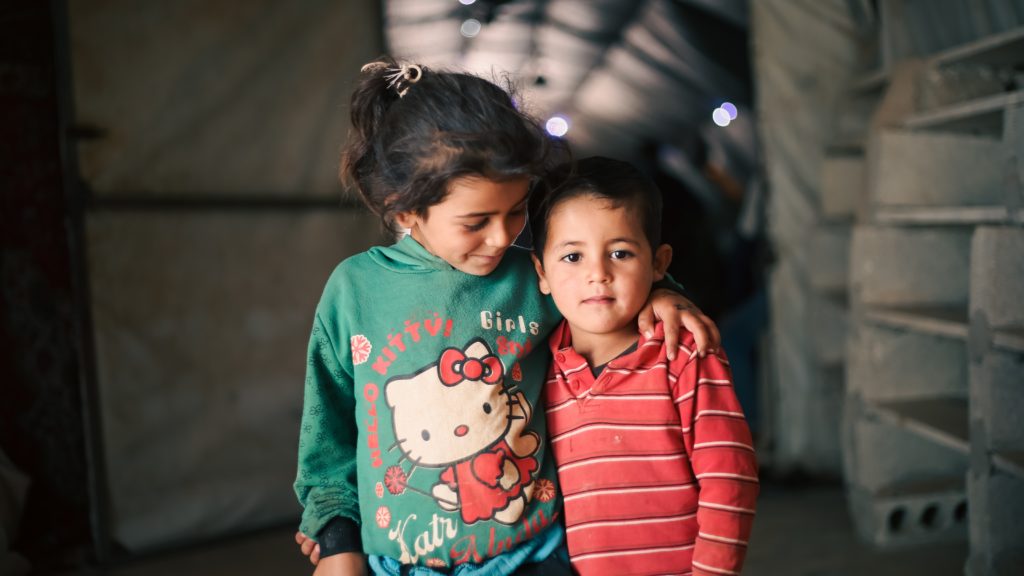War is regrettably nothing new in today’s reality. It has been estimated that over 400 million children are currently living in countries where wars or other types of violent conflicts are occurring and face disproportionate exposure to vicious and violent crimes. Children’s human rights are severely endangered and they are particularly deprived of the enjoyment of their fundamental rights, as they are an extremely vulnerable group during periods of conflict.

Key definitions
- A child is “any person under the age of eighteen” (Convention on the Rights of the Child: The children’s version).
- War is a “phenomenon of organized collective violence that affects either the relations between two or more societies or the power relations within a society. War is governed by the law of armed conflict” (The Practical Guide to Humanitarian Law).
- An international armed conflict (‘IAC’) “occurs when one or more States have recourse to armed force against another State, regardless of the reasons or the intensity of this confrontation” (International Committee of the Red Cross).
- Non-international armed conflicts (‘NIAC’) are “armed conflicts in which one or more non-State armed groups are involved. Depending on the situation, hostilities may occur between governmental armed forces and non-State armed groups or between such groups only” (International Committee of the Red Cross).
Protection from armed conflict under international law
The Convention on the Rights of the Child (‘CRC’)
States Parties must ensure the respect for rules of international humanitarian law applicable in armed conflicts which are relevant to children; take all feasible measures to ensure the protection and care of children affected by an armed conflict; and make every effort to ensure that persons who have not attained the age of fifteen years do not take a direct part in hostilities (CRC, Art.38).
The Geneva Conventions of 1949 (‘GCs’)
In times of conflict, children maintain their right to the protection of their cultural environment, their education, and the exercise of their religion (GCs, Arts.24 and 50). As soon as hostilities break out, parties to a conflict may establish hospitals and safety zones and localities to protect vulnerable groups such as children (GCs, Art.14). If in occupied territory, the application of any preferential measures with regard to food, medical care, and protection from the effects of war for children may not be hindered and children under the age of eighteen cannot be compelled to work (GCs, Arts.50 and 51).
The Additional Protocols of 1977 to the GCs (‘AP I’ and ‘AP II’)
Additional Protocol I relating to IACs, provides for the protection of children against any form of indecent assault and forbids children under fifteen years old to be recruited in armed forces (AP I, Art.77). Children benefit further from protections such as evacuation, care and aid, protection against assault and for wounded children, distribution of relief supplies, placement in internment with their families and facilitation to the reunion of dispersed families (AP I, Arts.8 and 70-78). Additional Protocol II, relating to NIACs, provides analogous protections to children (AP II, Arts.4 and 6).
War consequences on children’s fundamental rights
Right to life, protection and freedom
Since 2014, an average of 10,500 children are killed every year (UNICEF, 2022). Besides this staggering figure, children, both currently as well as in the past, have been recipients of great harm and crimes being committed by armed forces during times of conflict (UNICEF, 2022). Children are therefore stripped of their right to life and to protection from harm and exploitation.
Moreover, their right to freedom is equally violated during conflicts. Some children are being detained either as child soldiers or due to “their actual or perceived association with an armed group” or due to the lack of access to “appropriate forms of child justice” (International Committee of the Red Cross).
Right to food and to water
Many provisions of international humanitarian law ensure that persons or groups not/no longer taking part in hostilities shall not be denied of food (Jelena Pejic, 2001). Food supplies can become scarce in times of conflict and starvation can be used as a method of warfare (Jelena Pejic, 2001). Equally, safe drinking water can be used as a weapon of war and can also become insufficient as water supply tanks are inflicted with damage and disrepair from the armed conflict (UNICEF, 2017).
As a consequence, children’s rights to food and to water are alarmingly obstructed. When children do not have a sufficient diet and have no safe water to drink, it can lead to malnutrition, fatal diseases and the weakening of the immunity system (War Childhood Museum; UNICEF, 2017).
Right to education

Education can be a real life-saver for children during conflicts, because when they are not within school premises, they can easily become targets of abuse, exploitation and recruitment by armed forces (UNICEF). However, schools can be intentionally targeted, damaged collaterally, or used for military functions, shelters for displaced persons, and local illegal recruitment (International Committe of the Red Cross). By the same token, as refugees in another country, children are not guaranteed to gain access to a suitable education (United Nations, 2019).
Right to health
The paucity of medication, medical staff and adequate health services during conflicts can be the cause for the child mortality rate and for the morbidity toll increase (War Childhood Museum). Attacks are also aimed at hospitals, health workers and patients (United Nations, 2013). Given that children are still growing up and in development, physically and psychologically, their health is “seriously endangered in war” (War Childhood Museum). Not only does their right to health care become restricted or non-existent, but the damage and trauma inflicted by conflict-related horrors and crimes can unfortunately never be erased. (Psychiatric Times, 2022).
Repercussions of warfare on children’s daily lives
Victims of violence and atrocious crimes
Children, as civilians and as part of the most vulnerable group in the context of warfare, are more prone to witness and be victims of the most atrocious crimes committed during armed conflicts (War Childhood Museum). Indeed, children encounter first-hand the various crimes committed by armed forces, ranging from torture and injuries inflicted on children and escalating to murder (UNICEF, 2022). They are furthermore exposed to being injured or killed by land mines and explosives (UNICEF USA). Corollary grave crimes suffered by children during armed conflicts are abuse, abduction, exploitation, child trafficking, rape and other forms of sexual violence (UNICEF).
Enlistment as child soldiers
Abducted or recruited by force, children can be turned into child soldiers. A child soldier is “any person below eighteen years of age who is or who has been recruited or used by an armed force or armed group in any capacity, including but not limited to children, boys and girls” (The Paris Principles, 2007). Children are compelled to “fight on the front lines, participate in suicide missions, and act as spies, messengers, or lookouts” (Human Rights Watch, 2013). Not only that, they can also be forcibly used as cooks, sex slaves, or suicide bombers (Office of the Special Representative of the Secretary General for Children and Armed Conflict).
Orphans and displaced children
Children can also suffer from collateral effects of conflicts such as the loss or severance of family ties and their internal or external displacement (UNICEF, 2022). Isolated or separated from their family members or caregivers, children are even more at risk of abuse, exploitation, violence and being enlisted as child soldiers (International Committe of the Red Cross). In addition to this disruption of their lives, they might be forced to flee, either internally or to other countries, in order to escape the armed conflict. And as displaced persons or refugees, children are more exposed to “experience severe poverty, abuse, exploitation, and psychosocial distress” (Better Care Network).
Preventative and protective actions for children in war

Both the physical and mental integrity of children are gravely affected and violated in times of armed conflict. For this reason, precluding armed conflicts from transpiring is the most effective preventative action to guarantee a safe life for all children. If peacekeeping is however not achievable and an armed conflict unfolds, children must then benefit from a myriad of protective measures.
States and the international community must, as a matter of absolute priority, continuously cater to the needs of children and to the protection of their fundamental human rights. For this reason, the following actions should be encouraged and supported:
- Protecting all children from grave violations committed during times armed conflicts (UNICEF, 2022). This includes, inter alia, to prevent the killing, recruitment of child soldiers, detention, rape and other forms of sexual violence, abduction from being committed on children (UNICEF, 2022). Children’s rights to life, protection, freedom, food, water, education and health must at all times be ensured and protected.
- Ensuring that schools, hospitals and other civilian buildings are not attacked either as a means of warfare or as collateral damage (UNICEF, 2022).
- Facilitating family reunifications (UNICEF, 2022).
- Closely monitoring children in times of conflict in order to provide a better response and humanitarian aid (UNICEF, 2022).
- Engaging with all parties to the conflict in order to develop “Action Plans and sustainably protect children” (UNICEF, 2022).
Written by Moïra Phuöng Van de Poël
Internally proofread by Aditi Partha
Last updated on 18 June 2023
Bibliography:
Better Care Network. (n.d.). Children Affected by Armed Conflict and Displacement. Retrieved from Better Care Network at https://bettercarenetwork.org/library/particular-threats-to-childrens-care-and-protection/children-affected-by-armed-conflict-and-displacement, in April 2023.
Human Rights Watch. (2013). Children and Armed Conflict. Retrieved from Human Rights Watch at https://www.hrw.org/topic/childrens-rights/children-and-armed-conflict, in April 2023.
International Committe of the Red Cross. (n.d.). Protected persons: children. Retrieved from International Committe of the Red Cross at https://www.icrc.org/en/war-and-law/protected-persons/children, in April 2023.
International Committee of the Red Cross. (n.d.). Captured child combatants. Retrieved from International Committee of the Red Cross at https://www.icrc.org/en/doc/resources/documents/article/other/57jmea.htm, in May 2023.
International Committee of the Red Cross. (n.d.). Glossary. Retrieved from International Committee of the Red Cross at https://casebook.icrc.org/a_to_z/glossary/international-armed-conflict, in April 2023.
International Committee of the Red Cross. (1977, June 8). Protocol Additional I to the Geneva Conventions. Retrieved from International Committee of the Red Cross at https://ihl-databases.icrc.org/en/ihl-treaties/api-1977, in April 2023.
International Committee of the Red Cross. (1977, June 8). Protocol Additional II to the Geneva Conventions. Retrieved from International Committee of the Red Cross at https://ihl-databases.icrc.org/en/ihl-treaties/apii-1977, in April 2023.
International Committee of the Red Cross. (1949, August 12). The Geneva Conventions of 1949. Retrieved from International Committee of the Red Cross at https://www.icrc.org/en/doc/assets/files/publications/icrc-002-0173.pdf, in April 2023.
Jelena Pejic. (2001, December). The right to food in situations of armed conflict: The legal framework. Retrieved from International Committee of the Red Cross at https://www.icrc.org/en/doc/assets/files/other/irrc-844-pejic.pdf, in May 2023.
Médecins Sans Frontières. (n.d.). The Practical Guide to Humanitarian Law. Retrieved from Médecins Sans Frontières at https://guide-humanitarian-law.org/content/article/3/war/#:~:text=War%20is%20a%20phenomenon%20of,called%20%E2%80%9Cinternational%20humanitarian%20law.%E2%80%9D, in April 2023.
Office of the Special Representative of the Secretary General for Children and Armed Conflict. (n.d.). Child Recruitment and Use. Retrieved from United Nations at https://childrenandarmedconflict.un.org/six-grave-violations/child-soldiers/, in April 2023.
Psychiatric Times. (2022, March 8). The Psychosocial Impacts of War and Armed Conflict on Children. Retrieved from Psychiatric Times at https://www.psychiatrictimes.com/view/the-psychosocial-impacts-of-war-and-armed-conflict-on-children, in April 2023.
UNICEF. (2022, June). 25 years of children and armed conflict: taking action to protect children in war. Retrieved from UNICEF at https://www.unicef.org/media/123021/file/25%20Years%20Children%20in%20Armed%20Conflict.pdf, in April 2023.
UNICEF. (2022, April 8). As conflict changes, so do the dangers for children. Retrieved from UNICEF at https://www.unicef.org/blog/conflict-changes-so-do-dangers-children, in April 2023.
UNICEF. (2017, August 29). Children’s access to safe water and sanitation is a right, not a privilege. Retrieved from UNICEF at https://www.un.org/sustainabledevelopment/blog/2017/08/childrens-access-to-safe-water-and-sanitation-is-a-right-not-a-privilege-unicef/, in May 2023.
UNICEF. (n.d.). Convention on the Rights of the Child: The children’s version. Retrieved from UNICEF at https://www.unicef.org/child-rights-convention/convention-text-childrens-version#:~:text=A%20child%20is%20any%20person%20under%20the%20age%20of%2018, in April 2023.
UNICEF. (n.d.). Education under attack. Retrieved from UNICEF at https://www.unicef.org/education-under-attack, in May 2023.
UNICEF. (2007, February). The Paris Principles. Retrieved from UNICEF at https://www.unicef.org/mali/media/1561/file/ParisPrinciples.pdf, in April 2023.
UNICEF USA. (n.d.). Children in war and conflict. Retrieved from UNICEF USA at https://www.unicefusa.org/what-unicef-does/emergency-response/conflict, in April 2023.
United Nations. (1990, September 2). Convention on the Rights of the Child. Retrieved from United Nations at https://www.ohchr.org/sites/default/files/Documents/ProfessionalInterest/crc.pdf, April 2023.
United Nations. (2019, August 30). More than half of world’s refugee children ‘do not get an education’, warns UNHCR. Retrieved from United Nations at https://news.un.org/en/story/2019/08/1045281, in May 2023.
United Nations. (2013, November 5). Protecting Healthcare in Conflict, Protecting Future Generations. Retrieved from United Nations at https://childrenandarmedconflict.un.org/2013/11/protecting-healthcare-in-conflict/, in May 2023.
War Childhood Museum. (n.d.). Impact of War on Children. Retrieved from War Childhood Museum at https://warchildhood.org/impact-of-war-on-children/, in April 2023.

